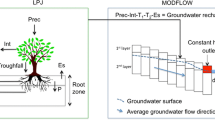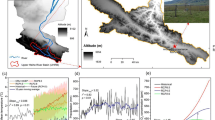Abstract
Assessments of the impacts of global change on carbon stocks in mountain regions have received little attention to date, in spite of the considerable role of these areas for the global carbon cycle. We used the regional hydro-ecological simulation system RHESSys in five case study catchments from different climatic zones in the European Alps to investigate the behavior of the carbon cycle under changing climatic and land cover conditions derived from the SRES scenarios of the IPCC. The focus of this study was on analyzing the differences in carbon cycling across various climatic zones of the Alps, and to explore the differences between the impacts of various SRES scenarios (A1FI, A2, B1, B2), and between several global circulation models (GCMs, i.e., HadCM3, CGCM2, CSIRO2, PCM). The simulation results indicate that the warming trend generally enhances carbon sequestration in these catchments over the first half of the twenty-first century, particularly in forests just below treeline. Thereafter, forests at low elevations increasingly release carbon as a consequence of the changed balance between growth and respiration processes, resulting in a net carbon source at the catchment scale. Land cover changes have a strong modifying effect on these climate-induced patterns. While the simulated temporal pattern of carbon cycling is qualitatively similar across the five catchments, quantitative differences exist due to the regional differences of the climate and land cover scenarios, with land cover exerting a stronger influence. The differences in the simulations with scenarios derived from several GCMs under one SRES scenario are of the same magnitude as the differences between various SRES scenarios derived from one single GCM, suggesting that the uncertainty in climate model projections needs to be narrowed before accurate impact assessments under the various SRES scenarios can be made at the local to regional scale. We conclude that the carbon balance of the European Alps is likely to shift strongly in the future, driven mainly by land cover changes, but also by changes of the climate. We recommend that assessments of carbon cycling at regional to continental scales should make sure to adequately include sub-regional differences of changes in climate and land cover, particularly in areas with a complex topography.
Similar content being viewed by others
References
Atkin OK, Tjoelker MG (2003) Thermal acclimation and the dynamic response of plant respiration to temperature. Trends Plant Sci 8(7):343–351
Band LE, Patterson P, Nemani R et al (1993) Forest ecosystem processes at the watershed scale: incorporating hill slope hydrology. Agric For Meteorol 63:93–126
Bebi P, Baur P (2002) Forest expansion in the Swiss Alps: a quantitative analysis of bio-physical and socio-economic causes. Austrian Journal of Forest Science 3/4:217–230
Beniston M, Diaz HF, Bradley RS (1997) Climatic change at high elevation sites: an overview. Clim Change 36:233–251
Beven KJ, Kirkby MJ (1979) A physically based, variable contributing area model of basin hydrology. Hydrol Sci Bull 24:43–69
Cairns DM, Malanson GP (1998) Environmental variables influencing the carbon balance at the alpine treeline: a modeling approach. J Veg Sci 9:676–692
Churkina G, Tenhunen J, Thornton P et al (2003) Analyzing the ecosystem carbon dynamics of four European coniferous forests using a biogeochemistry model. Ecosystems 6:168–184
Cramer W, Bondeau A, Woodward FI et al (2001) Global response of terrestrialecosystem structure and function to CO2 and climate change: results from six dynamic global vegetation models. Glob Chang Biol 7(4):357–373
Ewert F, Rounsevell MDA, Reginster I, Metzger M, Leemans R (2006) Technology development and climate change as drivers of future agricultural land use. In: Brouwer F, McCarl B (eds) Rural lands, agriculture and climate beyond 2015. Series “Environment & Policy”, vol. 46, Springer-Verlag, pp. 33–51
Foley JA, Levis S, Costa MH et al (2000) Incorporating dynamic vegetation cover within global climate models. Ecol Appl 10(6):1620–1632
Gifford RM (2003) Plant respiration in productivity models: conceptualisation, representation and issues for global terrestrial carbon-cycle research. Funct Plant Biol 30:171–186
Goodale CL, Apps MJ, Birdsey RA et al (2002) Forest carbon sinks in the Northern Hemisphere. Ecol Appl 12:891–899
Gordon WS, Famiglietti JS, Fowler NL, Kittel TGF, Hibbard KA (2004) Validation of simulated runoff from six terrestrial ecosystem models: results from VEMAP. Ecol Appl 14:527–545
Huber U, Bugmann H, Reasoner M (eds) (2005) Global change and mountain regions: a state of knowledge overview. Advances in global change research. Springer, Berlin Heidelberg New York, p 650
Huxman TE, Turnipseed AA, Sparks JP et al (2003) Temperature as a control over ecosystem CO2 fluxes in a high- elevation, subalpine forest. Oecologia 134(4):537–546
IPCC (Intergovernmental Panel of Climate Change) (2000) Special report on emission scenarios. Cambridge University Press, Cambridge, UK
Janssens IA, Freibauer A, Ciais P et al (2003) Europe’s terrestrial biosphere absorbs 7 to 12% of European anthropogenic CO2 emissions. Science 300:1538–1542
Karjalainen T, Pussinen A, Liski J et al (2003) Scenario analysis of the impacts of forest management and climate change on the European forest sector carbon budget. Forest Pol Econ 5:141–155
Kirschbaum MUF (2000) Forest growth and species distribution in a changing climate. Tree Physiol 20:309–322
Körner C (1998) A re-assessment of high elevation treeline positions and their explanation. Oecologia 115(4):445–459
Körner C, Paulsen J (2004) A world-wide study of high altitude treeline temperatures. J Biogeogr 31:713–722
Kramer K (1996) Phenology and growth of European trees in relation to climate change. Institute for Forestry and Nature Research, Wageningen, Landbouw Universiteit
Loveys BR, Atkinson LJ, Sherlock DJ et al (2003) Thermal acclimation of leaf and root respiration: an investigation comparing inherently fast- and slow-growing plant species. Glob Chang Biol 9:895–910
Mitchell TD, Carter TR, Jones PD et al (2004) A comprehensive set of high-resolution grids of monthly climate for Europe and the globe: the observed record (1901–2000) and 16 scenarios (2001–2100). Tyndall Centre Working Paper. (http://www.tyndall.ac.uk/publications/working_papers/wp55_summary.shtml)
Mooney HA, Canadell J, Chapin FS III et al (1999) Ecosystem physiology responses to global change. In: Walker B, Steffen W, Canadell J, Ingram J (eds) The terrestrial biosphere and global change. Cambridge University Press, Cambridge, UK pp 141–189
Morales P, Smith P, Sykes MT et al (2005) Comparing ecosystem model predictions of carbon and water fluxes in major European forest biomes. Glob Chang Biol 11:2211–2233
Nabuurs, GJ, Schelhaas MJ, Mohren GMJ et al (2003) Temporal evolution of the European forest sector carbon sink from 1950 to 1999. Glob Chang Biol 9:152–160
Reginster I, Rounsevell MDA (2003) Land use change scenarios for Europe. LUCC Newsl 9:10–11
Running SW, Hunt ERJ (1993) Generalization of a forest ecosystem process model for other biomes, BIOME-BGC, and an application for global-scale models. In: Ehleringer JR, Field CB (eds) Scaling physiological processes: leaf to globe. Academic, San Diego, CA, pp 141–158
Running SW, Nemani RR, Hungerford RD (1987) Extrapolation of synoptic meteorological data in mountainous terrain and its use for simulating forest evapotranspiration and photosynthesis. Can J For Res 17(6):472–483
Schimel D, Kittel TGF, Running S et al (2002) Carbon sequestration studied in Western U.S. mountains. EOS 83(40):445–448
Schmid S, Zierl B, Bugmann H (2006) Analyzing the ecosystem carbon dynamics of central European forests: comparison of Biome-BGC simulations with measurements. Reg Environ Change 6:167–180
Semenov MA, Barrow EM (1997) Use of a stochastic weather generator in the development of climate change scenarios. Clim Change 35:397–414
Sitch S, Smith B, Prentice IC et al (2003) Evaluation of ecosystem dynamics, plant geography and terrestrial carbon cycling in the LPJ dynamic global vegetation model. Glob Chang Biol 9(2):161–185
Smith P (2004) Carbon sequestration in croplands: the potential in Europe and the global context. Eur J Agron 20(3):229–236
Tague CL, Band LE (2004) RHESSys: regional hydro-ecologic simulation system: an object-oriented approach to spatially distributed modeling of carbon, water and nutrient cycling. Earth Interact 8(19):1–42
Thornton PE, Law BE, Gholz HL et al (2002) Modeling and measuring the effects of disturbance history and climate on carbon and water budgets in evergreen needleleaf forests. Agric For Meteorol 113:185–222
Tjoelker MG, Oleksyn J, Reich PB (2001) Modelling respiration of vegetation: evidence for a general temperature-dependent Q10. Glob Chang Biol 7(2):223–230
Valentini R, Matteucci G, Dolman AJ et al (2000) Respiration as the main determinant of carbon balance in European forests. Nature 404:861–865
Van Dijk A, Dolman AJ (2004) Estimates of CO2 uptake and release among European forests based on eddy covariance data. Glob Chang Biol 10:1445–1459
Waring RH, Running SW (1998) Forest ecosytems, analysis at multiple scales. Academic, New York, p 370
White MA, Running SW, Thornton PE (1999) The impact of growing-season length variability on carbon assimilation and evapotranspiration. Int J Biometeorol 42:139–145
Zierl B, Bugmann H, Tague CL (2007) Evaluation of water and carbon fluxes in the ecohydrological model RHESSys. Hydrol Process (in press)
Author information
Authors and Affiliations
Corresponding author
Rights and permissions
About this article
Cite this article
Zierl, B., Bugmann, H. Sensitivity of carbon cycling in the European Alps to changes of climate and land cover. Climatic Change 85, 195–212 (2007). https://doi.org/10.1007/s10584-006-9201-8
Received:
Accepted:
Published:
Issue Date:
DOI: https://doi.org/10.1007/s10584-006-9201-8




